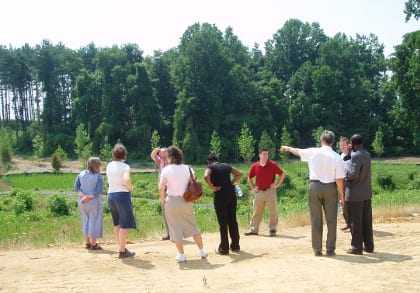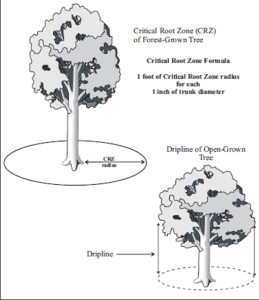by CJ Lammers
Preserving large trees in a new or renovated landscape is a complex task that requires the collaboration of many different professionals to be successful. Not only does the landscape designer need to understand the trees and their requirements for nutrients, light and air, but so do the architect and/or engineer designing the project. The other contractors who will be working on the site, such as electricians or hardscape contractors, also need to understand how trees function in order for the entire project to be successful. The problem is that these other professionals are not likely to take the time to learn about trees, so it’s the landscape designer’s job to understand all aspects of the other professions, their vision for the project, and how they will conduct their work on a site, to ensure that the trees can survive and thrive.

The most successful tree preservation projects are the result of careful planning with all professionals at the table. Photo: CJ Lammers
One of the benefits of the various green rating systems is that now the various professions are required to work collaboratively in an integrated design process. The most successful tree preservation efforts start with a partnership that includes the landscape designer and a Certified Arborist prior to the start of the design process. Unfortunately, tree and landscape professionals are frequently the last profession to be called into the design phase of a project, if we’re included at all. This means tree and landscape professionals have to become more proactive and educate the other professions we work with before the first truck arrives at the site.
Align Vision and Site Reality
If your project has a large scope, an architect, a site engineer and/or a land surveyor may be involved. When working with architects it’s important to understand their vision and design goals to ensure that they are compatible with the preservation of the existing trees. If their vision involves bumping out a wall into the yard and framing the view of the 36 inch diameter oak in the picture window, you’ve got to be sure that the tree is healthy enough to survive the construction and that the site work is designed to ensure the longevity of the tree. If the site engineer has a drainage problem to deal with and they’ve been tasked with ensuring that the site drains properly, and your task is to ensure the longevity of the beautiful river birches planted in a low area, you need to take into consideration both the existing and proposed soil conditions and drainage patterns. Detailed existing conditions plans are critical to understanding the topography and drainage – this is where you can and should partner with the land surveyor to ensure that all the spot elevations you need are obtained.

Examples of how a Critical Root Zone is measured. Many jurisdictions require a CRZ that is 1.5 times the diameter. A larger CRZ is recommended for trees of sensitive species or less than stellar condition. Source: Fairfax County, VA Public Facilities Manual
Before the design process begins, a site assessment is conducted and it should include an analysis of the existing trees’ sizes, species, conditions. Everyone wants to preserve the large trees on a site; however, large trees require a large area of undisturbed soil in order to ensure their longevity (often described as the “Critical Root Zone” or CRZ it encompasses an area with a radius in feet 1 to 1.5 times the diameter of the tree in inches proposed to be preserved). Too often the site is too tight and the required amount of undisturbed soil area for the tree’s roots is not available. Tree species is also an important determinant of whether or not a tree should be considered for preservation. For example, some species such as tulip poplar and American beech are particularly sensitive to change, whereas oaks are generally more tolerant of construction. These two aspects, combined with the tree’s current health and previous impacts, should be considered before projects are designed to preserve them. This information should be noted clearly and succinctly on a base plan with the critical root zones shown with simple notations such as “36 inch red oak, poor condition.”
Plan Around Tree Needs
After the site assessment has been completed, the design team should discuss the vision and scope of the project and the client’s needs. The arborist who completed the analysis should be included in these meetings – we’re trained to ask a multitude of questions about all aspects of the design and how the project will be built, the sequence of tasks, and the need for areas for staging of materials. This type of planning and communication helps to ensure that the necessary amount of undisturbed space required for preservation of the trees will be available. If an outdoor lighting system is being designed, for example, will the conduits be trenched into the ground? If so, the damage to a tree’s root system could be fatal. Will the base materials for the rear patio need to be moved to the backyard using a large piece of equipment? If so, then measures will be needed to protect the root systems of trees to be preserved.
The collaboration should continue throughout the design phase with a re-evaluation of the feasibility of preserving specific trees at the 80 percent design phase. At this point, enough of the detailed design issues will be known, and the landscape designer or arborist can provide a more educated opinion on whether or not the trees will survive the proposed construction.
If the preservation of a particular tree is critical to the overall vision, then some aspects of the design may need to be changed, such as moving the placement of a retaining wall or walkway, or using more tree friendly construction methods such as boardwalks, piers, or tunneling of utilities. Some hand excavation or use of lower impact equipment may also be necessary. All these methods can affect the project cost, so they need to be discussed by the design team and decided upon before the project starts.
Construct a Tree Preservation Plan
At this point in the design process a tree preservation plan can be prepared. This plan uses the site plan as its base and illustrates where tree preservation devices will be placed on the site such as tree protection fencing, root protection devices, and signage. It also contains a variety of notes that include site and tree specific treatments and general notes that apply to all sites. A good tree preservation plan is clear, concise, and easily understood by all contractors.
The collaboration of all players needs to continue through the construction phase as well. A pre-construction meeting is a must and should include all the contractors that will be working on the site. If they can’t all be present, it’s recommended that they be sent a copy of the tree preservation plan ahead of their arrival on the site. Sometimes general contractors will include a penalty clause in their subcontracts to ensure conformance with the tree preservation plan.
Damage to trees, unlike damage to a utility or a sidewalk, cannot be repaired. Once soil is compacted, or the trunk of a tree is wounded, this damage is permanent. In order to ensure the success of a project that involves tree preservation, all the professionals on a site must work together. The trees are depending on it.
About the Author
CJ Lammers is a nationally-known speaker and advocate for all things green. For 28 years she has worked tirelessly with state and local governments to move the ball forward on various topics including tree and forest preservation, small and large landscape conservation, and environmental land use policies and strategies. As a Master Environmental Planner, she implements environmental legislation and advises decision-makers on agricultural, forestry, and general ecology issues. She is the primary author of the first-ever functional land use plan for the environment at the county scale, taught for five years in the Landscape Design Program at George Washington University, and was one of the founding professors in GWU’s Sustainable Landscapes Program in 2007. CJ may be reached at cjlamm25@gmail.com.

